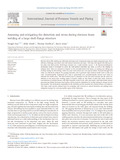JavaScript is disabled for your browser. Some features of this site may not work without it.
| dc.contributor.author | Sun, Yongle | |
| dc.contributor.author | Smith, Mike | |
| dc.contributor.author | Dutilleul, Thomas | |
| dc.contributor.author | Jones, Steve | |
| dc.date.accessioned | 2022-09-14T11:00:49Z | |
| dc.date.available | 2022-09-14T11:00:49Z | |
| dc.date.issued | 2022-08-30 | |
| dc.identifier.citation | Sun Y, Smith M, Dutilleul T, Jones S. (2022) Assessing and mitigating the distortion and stress during electron beam welding of a large shell-flange structure. International Journal of Pressure Vessels and Piping, Volume 199, October 2022, Article number 104772 | en_UK |
| dc.identifier.issn | 0308-0161 | |
| dc.identifier.uri | https://doi.org/10.1016/j.ijpvp.2022.104772 | |
| dc.identifier.uri | https://dspace.lib.cranfield.ac.uk/handle/1826/18450 | |
| dc.description.abstract | Electron beam (EB) welding can efficiently join large-scale components using one single autogenous pass, but it still faces challenges associated with weld-induced distortion and stress. This study investigates EB welding in a low-alloy steel thick-section shell-flange structure for a small modular reactor. A 3D thermal-metallurgical-mechanical model is developed to assess the weld-induced distortion and stress, as well as the strategy to mitigate them. When no restraint is imposed on the circumferential weld plane, an opening and sliding gap develops during the EB welding, which can cause weld defects and even process failure. Restraint through tack welds can effectively mitigate the gapping distortion, but it generates high transient tensile stress in the tack weld. Circumferentially continuous tack weld is preferential over circumferentially discrete tack welds to minimise the tensile stress. The final residual stress is insensitive to the tack-weld restraint, and the stress distribution in the steady-state welding region is broadly similar to that found in plate butt welds. However, concentration of residual stresses with high triaxiality occurs in the weld stop region, with high tensile stresses generated just behind the beam stop location, which cannot be diminished by overlap welding or change of weld stop position. The mechanisms responsible for the distortion and the transient and residual stresses are analysed. This study could provide rational basis for designing weld restraint to control distortion and guiding stress mitigation strategy for crack-susceptible region in EB weldments. | en_UK |
| dc.language.iso | en | en_UK |
| dc.publisher | Elsevier | en_UK |
| dc.rights | Attribution 4.0 International | * |
| dc.rights.uri | http://creativecommons.org/licenses/by/4.0/ | * |
| dc.subject | Fusion welding | en_UK |
| dc.subject | Weld restraint | en_UK |
| dc.subject | Nuclear steel | en_UK |
| dc.subject | Distortion | en_UK |
| dc.subject | Transient stress | en_UK |
| dc.subject | Residual stress | en_UK |
| dc.subject | Modelling | en_UK |
| dc.title | Assessing and mitigating the distortion and stress during electron beam welding of a large shell-flange structure | en_UK |
| dc.type | Article | en_UK |
Files in this item
The following license files are associated with this item:
This item appears in the following Collection(s)
-
Staff publications (SATM) [4367]

